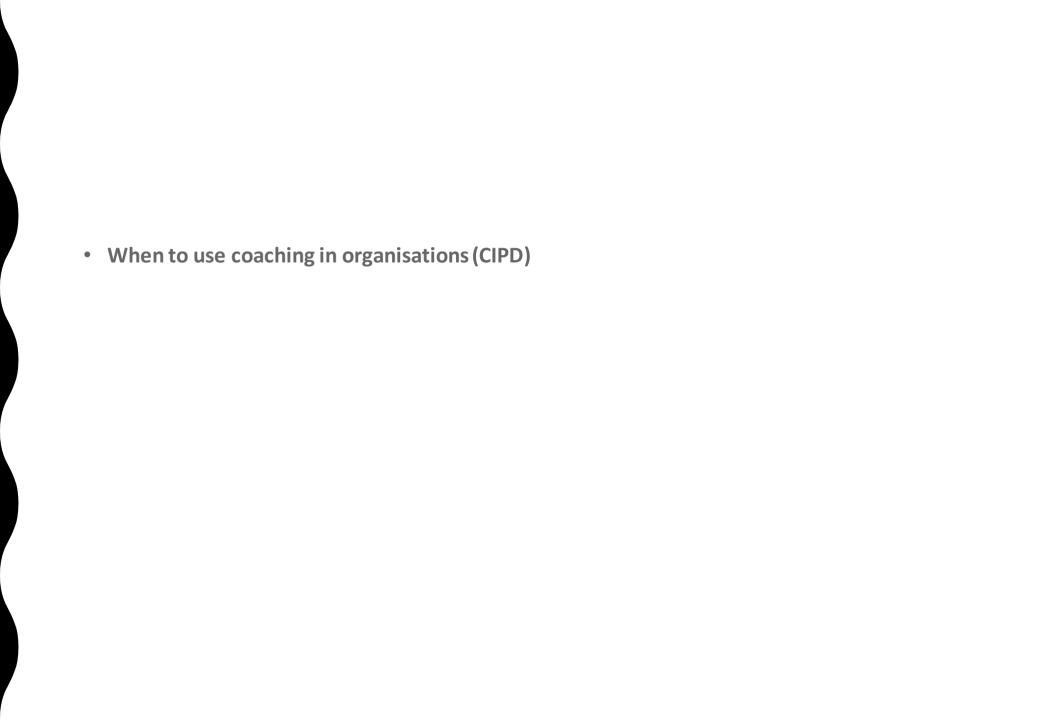
2 minute read
Assessment
Criteria AC 1.5 Conduct a cost/benefit analysis of a coaching and mentoring process to support achievement of organisational strategic performance objectives.
All assessment criteria must be addressed as individual pieces of evidence
Advertisement
Best Practice for AC 1.5
Costs:
• Staff time (coaches, mentors, coachees, mentees) including staff cover for coaching and mentoring activities and supervision of coaches and mentors; lost ‘opportunity cost’ e.g. loss of chargeable time whilst participating in coaching and mentoring activity
• Cost of training, qualifications, accreditations
• Administration and management time for the initiative
• ‘Housekeeping’ items: stationery, accommodation etc
• Cost of launching and publicising/communicating the initiative
Benefits: It should be borne in mind that, in actuality, establishing ‘impact’ and ‘effect’ is often a difficult causal link to demonstrate from a specific development activity, and Learners could consider how (ideally in their own organisational context), the value of coaching and mentoring would manifest in order that the ‘return on investment (ROI) or ‘return on expectations’ of the coaching and mentoring programme can be measured appropriately.
Assessment Criteria
AC 1.5 Conduct a cost/benefit analysis of a coaching and mentoring process to support achievement of organisational strategic performance objectives.
An example of this could be that one of the objectives for a coaching programme might be to reduce a high turnover rate in the population of new managers. This would, in turn inform the measures/metrics that might be engaged as part of the review and evaluation process to identify impact/effect.
Assessment Criteria
AC 1.5 Conduct a cost/benefit analysis of a coaching and mentoring process to support achievement of organisational strategic performance objectives.
All assessment criteria must be addressed as individual pieces of evidence
Best Practice for AC 1.5
Other examples of ways in which impact/effect might be demonstrated could include, but are not confined to:
• Using a performance improvement cycle to demonstrate how issues have been addressed through coaching and mentoring
• Through appraisal or supervision processes or other methods of performance review against a framework of objectives
• By establishing a baseline measure for areas of organisational, team or individual performance that require improvement through coaching and mentoring; thus enabling changes to performance to be identified e.g. turnover levels in a department, levels of competence, absence levels
Learning Outcome Two Understand the impact of organisational culture on coaching and mentoring
Assessment Criteria Learning Outcome 2
Assessment Criteria AC 2.1 Determine how organisational culture can impact on coaching
Assessment Criteria AC 2.2 Determine how organisational culture can impact on mentoring
The Command verb and focus it DETERMINESettle/conclude an argument/question as a result of investigation or by referring to an authority.
Assessment Criteria Learning Outcome 2
Assessment Criteria AC 2.3 Evaluate the current cultural influences that may inhibit coaching
Assessment Criteria AC 2.3 Evaluate the current cultural influences that may inhibit mentoring
Assessment Criteria AC2.4 Evaluate the current cultural influences that may inhibit mentoring.
Assessment Criteria AC 2.5 Evaluate the current cultural influences that may support coaching.
Assessment Criteria AC 2.6 Evaluate the current cultural influences that may support mentoring
The Command verb is Evaluate - Consider the strengths and weaknesses, arguments for and against and/or similarities and differences. The writer should then judge the evidence from the different perspectives and make a valid conclusion or reasoned judgement. Apply current research or theories to support the evaluation when applicable.
Learning Outcome Two Understand the impact of organisational culture on coaching and mentoring
Best Practice Learning Outcome Two - All assessment criteria must be addressed as individual pieces of evidence
2.1-2.6 This learning outcome would benefit from an introductory statement that defines what is meant by ‘organisational culture’ ideally, supporting this with references from recognised contributors to the body of knowledge that include (but are not limited to):
Morgan, Schein, Handy, Huczynski and Buchanan, Hofstede, Johnson and Scholes and many others.
A highly illustrative means of depicting organisational culture is to use the ‘cultural web’ model (Johnson and Scholes and others) and, Learners could consider using this to illustrate their own organisational culture and the influences within it.







